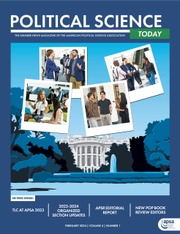While some revolutions last, others quickly fall victim to counterrevolution. What leads to these divergent outcomes? The use of violence by rebels during revolutionary upheaval might have a role in preventing future political clapback from the deposed regime as Killian Clarke finds in his recent APSR article on counterrevolutions and their causes.
Existing research on revolutions is well established and shows that non-violent revolution is the best way to oust undesirable governments. The use of non-violence means that these types of revolutions gain their power by attracting many supporters. Mobilizing a significant portion of the population is how such revolutions build their non-violent coercive power. They then use the size and breadth of their opposition to persuade the government to relinquish control. However, herding so many people together is not easy as it requires cooperation across a variety of ethnic, social, and economic lines. The loose ties tethering these groups together during revolution inevitably break down over time. This leaves the new government vulnerable and without much defense against deposed members of the old guard eager to recapture power.

As an alternative, Clarke suggests that use of violence during revolution might explain how some new governments have an easier time avoiding a political rebound by counterrevolutionaries. The use of violence may antagonize the previous regime into action, but it might also muffle any opportunities the old regime sees to retake power. Whether violence instigates or dissuades the emergence of a counterrevolution is unclear. Yet, the use of violence does allow revolutionary movements vying for political power to develop military strength. Clarke elaborates that cultivating a competent and loyal military is important for revolutionary parties, because it gives them the capacity to put down any counterrevolutions that arise.
Clarke vigorously examines these theories using multiple tests. To begin, he creates a new dataset that captures all counterrevolutions from 1900-2015. He uses these data to test whether the use of violence by a revolutionary group is associated with the emergence of a counterrevolution or the success of a counterrevolution. To capture “violence,” Clark uses three different measures: the number of deaths during revolution, the presence of a revolutionary army, and whether the revolution involved a civil war. Tests using each of these different metrics yielded the same result—the use of violence by revolutionaries reduces the likelihood of a successful return to power by the previous regime. In fact, Clarke finds that since 1900, revolutionary regimes with some sort of military body are overthrown only 5 times by counterrevolution, while revolutionary regimes without a military are overthrown 17 times.
Lastly, Clarke uses two case studies from Cuba to test the viability of his theory, comparing the experience of the Gobierno de 100 días of 1933 against the Cuban Revolution of 1959. In 1933, a hodge-podge of groups assembled to oust President Gerardo Machado, including leftists, students, and even junior military officers. Following the non-violent overthrow, infighting between the groups splintered the movement, causing the new government to quickly collapse against a counterrevolutionary offense led by military officer Fulgencio Batista. In 20 short years, Cuba would face another revolution, this time with Batista being sent packing by Fidel Castro. In contrast to the 1933 uprising, the 1959 revolutionaries were well-versed in violence. They not only used urban insurgency but also developed a strong rebel army in the rural front. The development of a battle-proven rebel force and its effective use of violence successfully forced Batista to relinquish power, allowing the revolutionaries to take control of the government – and keep it. Despite similar conditions, the two cases have very distinct outcomes. Clarke identifies the distinguishing factor to be the use of violence vis-à-vis the development of a rebel army. This finding acts as the third nail to validate his theory and the evidence indicates it is the use of violence by rebels that helps revolutionary governments withstand political clapback from counterrevolutionaries.
From this, we can draw a somewhat uncomfortable conclusion. Clarke’s work suggests that revolutions which avoid losing power to the old regime do so by employing violence during the initial revolution. Yet, there are two important factors to consider. Research on counterrevolutions is relatively new and needs to be explored much further before a bold line can be drawn between the use of violence and the durability of revolution. Secondly, if revolutions are susceptible to counterrevolution, any measurement of “violence” should be extended to include any counterrevolutions that arise. Using this wider measure would capture the true level of violence. Moreover, because non-violent revolutions are vulnerable to counterrevolutions, this holistic view may reveal that non-violent revolutions are not so non-violent after all. Perhaps the uncomfortable truth is that in the long run, violent revolutions may result in less violence.
CLARKE, KILLIAN. 2022. “Revolutionary Violence and Counterrevolution.” American Political Science Review, 1–17. https://doi.org/10.1017/S0003055422001174.


